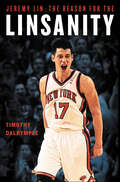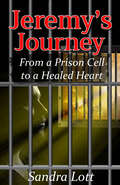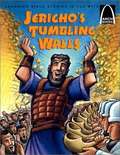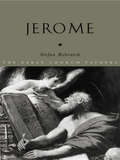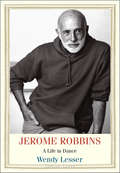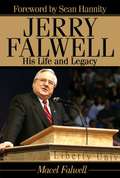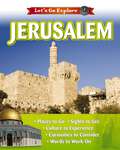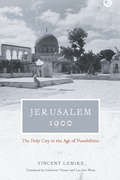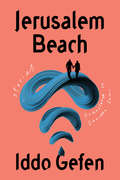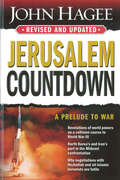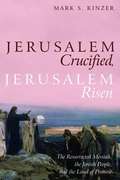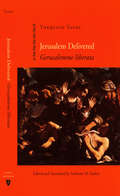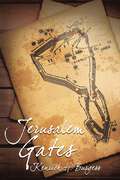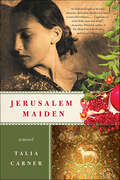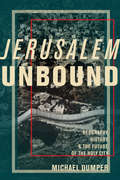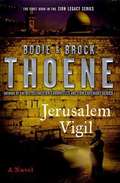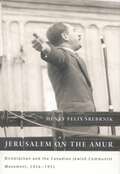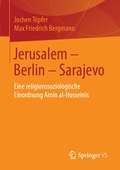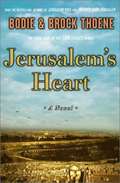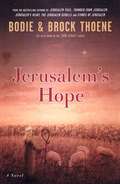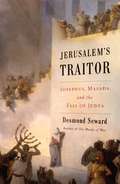- Table View
- List View
Jeremy Lin: The Reason for the Linsanity
by Timothy DalrympleHarvard graduate Jeremy Lin recently became a New York Knicks phenomenon and he's the NBA's first American-born player of Taiwanese descent. The book will chronicle Lin's high school, college and early career in the NBA with particular emphasis on the media explosion surrounding his success as starting point guard with the Knicks. It will explore how Jeremy's Christian faith, family, education and cultural inheritance have contributed to his success. The book will also include interviews with basketball experts on Jeremy's future in the NBA, Asian-American thought leaders on the role of race in Jeremy's rise to stardom, and renowned Christian athletes and pastors on the potent combination of faith and sports.
Jeremy's Journey: From a Prison Cell to a Healed Heart
by Sandra LottA harrowing tale of one man&’s battle to heal from his pain, resist the temptations of darkness, and free himself from his spiritual prison. Jeremy was full of life and laughter as a child. Then, suddenly, darkness invaded his life without warning. The darkness came from someone he looked up to and it stole the joy from his heart. It was one thing after another, and his joy was replaced with despair, and his will to live was gone. Darkness and drugs are the life he knows now—and prison awaits. Will he find life, love, and the healing which can only come from Jesus Christ? Will he see the light? Will he know the light, and will he let the light of Jesus in and restore what was lost?
Jericho's Tumbling Walls: The Story of Joshua and the Battle of Jericho
by Joan E. CurrenFrom the book: "Choose 12 strong men to bring 12 rocks / From riverbed now dry. / Build an altar so all will know, / This miracle is why."
Jerome (The Early Church Fathers)
by Stefan RebenichAs a scholar, writer and ascetic, Jerome was a major intellectual force in the early Church and influenced the ideals of Christian chastity and poverty for many generations after his death. This book assembles a representative selection of his voluminous output. It will help readers to a balanced portrait of a complex and brilliant, but not always likeable man.
Jerome Robbins: A Life in Dance (Jewish Lives)
by Wendy LesserA lively and inspired biography celebrating the centennial of this master choreographer, dancer, and stage director Jerome Robbins (1918–1998) was born Jerome Wilson Rabinowitz and grew up in Weehawken, New Jersey, where his Russian-Jewish immigrant parents owned the Comfort Corset Company. Robbins, who was drawn to dance at a young age, resisted the idea of joining the family business. In 1936 he began working with Gluck Sandor, who ran a dance group and convinced him to change his name to Jerome Robbins. He went on to become a choreographer and director who worked in ballet, on Broadway, and in film. His stage productions include West Side Story, Peter Pan, and Fiddler on the Roof. In this deft biography, Wendy Lesser presents Jerome Robbins’s life through his major dances, providing a sympathetic, detailed portrait of her subject.
Jerry Falwell
by Sean Hannity Macel FalwellAn intimate perspective into the life of the most visible religious leader in America, as told and authorized by his wife. Jerry Falwell played a pivotal role in the American religious and political scene for the last thirty years. As a constant voice for the Christian Right, and with his strong affirmations for family values, he remained outspoken about his beliefs and vision for revolutionized morals and social reform, including issues that will greatly affect the upcoming 2008 elections. Readers will be treated to a behind-the-scenes look at the private life of Jerry Falwell, giving insight into his most publicized and controversial events, such as: His friendship with Ronald Reagan His relationship to Larry Flynt What led to the concept and formation of the Moral Majority The reaction to his September 11 remarks Macel Falwell, Rev. Falwell's widow, provides this official biography of the founder of the Moral Majority. Along with never-before-seen photographs, Macel gives a personal viewpoint and tells readers stories from across the decades, including some from his children, that show the man behind the passion.
Jerry Falwell and the Rise of the Religious Right: A Brief History With Documents
by Matthew Avery SuttonAs one of the most media-savvy ministers in U.S. history, Jerry Falwell figured prominently in the political mobilization of religious conservatives in the 1970s and early 1980s. Falwell’s life and work touched on almost all of the major issues of the time period: the cold war, changing gender roles, civil rights, the revitalization of American conservatism, and the Reagan revolution. <P><P> In his introductory essay, Matthew Avery Sutton traces Falwell’s politicization and rise to celebrity status, using Falwell as a lens through which to view the larger movement. More than two dozen primary documents focus on the Religious Right’s emergence in the 1970s as a powerful political force and present students with first-hand accounts of the era’s culture wars. <P><P>The thematically arranged documents – including sermons, letters, speeches, interviews, court documents, and children’s books – provide an up-close look at the motivations and aspirations of the Religious Right. Photographs, document headnotes, a chronology, questions for consideration, and a selected bibliography provide additional pedagogical support.
Jerusalem (Let's Go Explore)
by ZondervanIn this full-color picture book, Let&’s Go Explore Jerusalem, young readers travel to the holy land of Jerusalem. Complete with photographs, maps, vocabulary call-outs, fun facts, and more, this is the perfect resource for the young explorer. Read about the Biblical significance and history of Israel as well as current and curious information about foods, clothes, places of interest, and other pertinent facts of interest.
Jerusalem 1900: The Holy City in the Age of Possibilities
by Catherine Tihanyi Lys Ann Weiss Vincent LemirePerhaps the most contested patch of earth in the world, Jerusalem’s Old City experiences consistent violent unrest between Israeli and Palestinian residents, with seemingly no end in sight. Today, Jerusalem’s endless cycle of riots and arrests appears intractable—even unavoidable—and it looks unlikely that harmony will ever be achieved in the city. But with Jerusalem 1900, historian Vincent Lemire shows us that it wasn’t always that way, undoing the familiar notion of Jerusalem as a lost cause and revealing a unique moment in history when a more peaceful future seemed possible. In this masterly history, Lemire uses newly opened archives to explore how Jerusalem’s elite residents of differing faiths cooperated through an intercommunity municipal council they created in the mid-1860s to administer the affairs of all inhabitants and improve their shared city. These residents embraced a spirit of modern urbanism and cultivated a civic identity that transcended religion and reflected the relatively secular and cosmopolitan way of life of Jerusalem at the time. These few years would turn out to be a tipping point in the city’s history—a pivotal moment when the horizon of possibility was still open, before the council broke up in 1934, under British rule, into separate Jewish and Arab factions. Uncovering this often overlooked diplomatic period, Lemire reveals that the struggle over Jerusalem was not historically inevitable—and therefore is not necessarily intractable. Jerusalem 1900 sheds light on how the Holy City once functioned peacefully and illustrates how it might one day do so again.
Jerusalem Beach: Stories
by Iddo Gefen"This vigorous, inventive work will surely fire up readers' neurons." — Starred Review, Publisher's Weekly For fans of Etgar Keret, a debut collection that fuses the humor of everyday life in Israel with technology's challenges and the latest discoveries about the human brain.At once compassionate, philosophical, and humorous, Jerusalem Beach is a foray into the human condition in all its contradictions. Through a series of snapshots of contemporary life in Israel, Gefen reveals a world that&’s a step from the familiar. A man&’s grandfather joins an army platoon of geriatrics looking for purpose in old age. A scheming tech start-up exposes the dire consequences of ambition in trying to share human memories. An elderly couple searches for a beach that doesn&’t exist. And, a boy mourns his brother&’s death in an attempt to catch time like flies in his fist. Entirely heartfelt and infused with pathos, Jerusalem Beach is an exploration of both technology and the brain. Whether ruminating on the stakes of familial love or pitching the reader headlong into the absurdity of success and failure, Gefen leaves the reader intrigued throughout.
Jerusalem Besieged: From Ancient Canaan to Modern Israel
by Eric H. Cline"Jerusalem Besieged is a fascinating account of how and why a baffling array of peoples, ideologies, and religions have fought for some four thousand years over a city without either great wealth, size, or strategic importance. Cline guides us through the baffling, but always bloody, array of Jewish, Roman, Moslem, Crusader, Ottoman, Western, Arab, and Israeli fights for possession of such a symbolic prize in a manner that is both scholarly and engaging. " -Victor Davis Hanson, Stanford University; author ofThe Other GreeksandCarnage and Culture "A beautifully lucid presentation of four thousand years of history in a single volume. Cline writes primarily as an archaeologist-avoiding polemic and offering evidence for any religious claims-yet he has also incorporated much journalistic material into this study. Jerusalem Besieged will enlighten anyone interested in the history of military conflict in and around Jerusalem. " -Col. Rose Mary Sheldon, Virginia Military Institute "This groundbreaking study offers a fascinating synthesis of Jerusalem's military history from its first occupation into the modern era. Cline amply deploys primary source material to investigate assaults on Jerusalem of every sort, starting at the dawn of recorded history. Jerusalem Besieged is invaluable for framing the contemporary situation in the Middle East in the context of a very long and pertinent history. " -Baruch Halpern, Pennsylvania State University A sweeping history of four thousand years of struggle for control of one city "[An] absorbing account of archaeological history, from the ancient Israelites' first conquest to today's second intifada. Cline clearly lays out the fascinating history behind the conflicts. " -USA Today "A pleasure to read, this work makes this important but complicated subject fascinating. " -Jewish Book World "Jerusalem Besieged is a fascinating account of how and why a baffling array of peoples, ideologies, and religions have fought for some four thousand years over a city without either great wealth, size, or strategic importance. Cline guides us through the baffling, but always bloody, array of Jewish, Roman, Moslem, Crusader, Ottoman, Western, Arab, and Israeli fights for possession of such a symbolic prize in a manner that is both scholarly and engaging. " -Victor Davis Hanson, Stanford University; author of The Other Greeks and Carnage and Culture
Jerusalem Betrayed: Acient Prophecy and Modern Conspiracy Collide in the Holy City
by Michael EvansFrom one of America's leading experts on Israel and the Middle East, this riveting book is the true story of what is happening in the cabinet rooms and war rooms across the world-Jerusalem's final betrayal brokered in the name of the Middle East.
Jerusalem Countdown, Revised and Updated: A Prelude To War
by John HageeBEST SELLER WITH OVER 1 MILLION COPIES SOLD World War III Has Begun! This revision of Jerusalem Countdown, updated to address the recent conflict with Hezbollah, the roles of North Korea and Syria in the coming nuclear showdown, and the infiltration of Islamic terrorists on American soil. Enhancing the message of the original edition, which has sold more than 800,000 copies, John Hagee anticipates Israel&’s strategies toward the Iranian threat and the resulting effect upon America. Hagee skillfully unveils the reasons radical Islam and Israel cannot dwell peaceably together as he paints a convincing picture explaining why Christians must support the State of Israel. About the AuthorJohn Hagee is the senior pastor of Cornerstone Church in San Antonio, Texas. The nondenominational evangelical church now has more than 18,000 active members. Known best nationally for his End-Times writings, he has authored several fiction and nonfiction best sellers.
Jerusalem Crucified, Jerusalem Risen: The Resurrected Messiah, the Jewish People, and the Land of Promise
by Mark Kinzerhe good news (euangelion) of the crucified and risen Messiah was proclaimed first to Jews in Jerusalem, and then to Jews throughout the land of Israel. In Jerusalem Crucified, Jerusalem Risen, Mark Kinzer argues that this initial audience and geographical setting of the euangelion is integral to the eschatological content of the message itself. While the good news is universal in concern and cosmic in scope, it never loses its particular connection to the Jewish people, the city of Jerusalem, and the land of Israel. The crucified Messiah participates in the future exilic suffering of his people, and by his resurrection offers a pledge of Jerusalem's coming redemption. Basing his argument on a reading of the Acts of the Apostles and the Gospel of Luke, Kinzer proposes that the biblical message requires its interpreters to reflect theologically on the events of post-biblical history. In this context he considers the early emergence of Rabbinic Judaism and the much later phenomenon of Zionism, offering a theological perspective on these historical developments that is biblically-rooted, attentive to both Jewish and Christian tradition, and minimalist in the theological constraints it imposes on the just resolution of political conflict in the Middle East." Kinzer also briefly discusses Messianic Judaism in terms of its relationship to Zionism and to his overarching thesis stated above. While his foundational texts are Luke and Acts, he also supports his arguments by analyzing other biblical texts and non-biblical sources in his main text and in his extensive footnotes.
Jerusalem Delivered (Gerusalemme liberata): Gerusalemme Liberata
by Torquato TassoLate in the eleventh century the First Crusade culminated in the conquest of Jerusalem by Christian armies. Five centuries later, when Torquato Tasso began to search for a subject worthy of an epic, Jerusalem was governed by a sultan, Europe was in the crisis of religious division, and the Crusades were a nostalgic memory. Tasso turned to the First Crusade both as a subject that would test his poetic ambition and as a reflection on the quandaries of his own time. He sought to create a masterpiece that would deserve comparison with the great epics of the past.Gerusalemme liberata became one of the most widely read and cherished books of the Renaissance. First published in 1581, it was translated into English by Edward Fairfax in 1600. That translation has been the standard, even though Fairfax was only a good, not a great, poet. Fairfax tried to fit Tasso's verse into Spenserian stanzas, adding to and subtracting from the original and often changing Tasso's meaning.Anthony Esolen's new translation captures the delight of Tasso's descriptions, the different voices of its cast of characters, the shadings between glory and tragedy—and it does all this in an English as powerful and clear as Tasso's Italian. Tasso's masterpiece finally emerges as an English masterpiece.
Jerusalem Gates
by Kenrick BurgessJerusalem is no ordinary place. It is a symbolic city. David, the most revered king of Israel, captured the city and established it as the capital of Israel approximately 3000 years ago. His son King Solomon built the glorious and first temple in the city. The preservation and focus of Jerusalem through centuries past to the present are not accidents. God has kept Jerusalem throughout many wars and battles. Jerusalem is the city that God has chosen for Himself to put His name.Jerusalem Gates examines the significance of the twelve gates built-in the walls around Jerusalem in the time of Nehemiah. The significant spiritual truths for both the individual’s Christian life as well as God’s prophetic plan for the ages are revealed. The order and position of each gate tell the story of God’s plan for people of every generation and the individual decisions that we must take to fulfil His preferred destiny for our lives. The book is divided into three sections:Section One provides insights into the early history of East Jerusalem, its wars, challenges, defeats, victories, sites, prophesies, and the opening of the embassy of the United States of America there on May 14, 2018. The views of Scriptures about Jerusalem are also shared.Section Two explains the significance of each of the twelve gates which were strategically located and named. You will learn about:-the sacrificial Lamb at the sheep gate;-the work of the Holy Spirit at the fountain gate:-the tried, tested and proven sword of the Holy Spirit and its effect on your life at the water gate;-the return of Jesus Christ and your need to live with hope for His return at the east gate;You will also learn how to:-receive the “crown of rejoicing” at the fish Gate;-be holy, obtain the legacy of our fathers in the faith, and get your “ministry call from God” at the old gate;-walk through the valleys of trials, tribulations. difficulties and troubles that will come your way and how to overcome should your “Gethsemane” be turned into a garden of suffering, betrayal, agony, abandonment, and loneliness at the valley gate;-eliminate the impediments, mental clutter and distractions that would hinder you from running the race of life to win “gold” at the dung gate;-battle and overcome the daily spiritual warfare that you encounter at the horse gate;-live our lives with eternity’s values in view at the inspection gate;-appreciate the great hymns and songs that kept the heroes of our faith through the years, and more. Section Three takes you through an exciting adventure into and life-changing insights about the new Jerusalem, its inhabitants, size, foundations, walls, and twelve gates. It is the eternal city of righteousness and peace and is built by God. At the heart of the book is the Christian’s journey through eleven of the gates to fulfil his or her God-directed destiny.
Jerusalem Interlude (The Zion Covenant #4)
by Bodie Thoene Brock ThoeneFor Jews in prewar Europe, the terrifying truth is uncovered: Truly they have no place to go. Escape or perish, but escape to where! As Central Europe is taken over by the Nazis under celebrated headlines of Peace in Our Times, hundreds of thousands pay the price for Hitler's international deception. In Jerusalem Interlude, Leah and Shimon Feldstein finally reach the Promised Land. They enter their new life under the shadow of the Western Wall, only to find that a longer, more sinister shadow is casting its darkness over the Holy Land. Will they ever find true peace, a resting place for their spirits? Or will their time in Jerusalem be only a brief interlude in the ongoing struggle for a homeland?
Jerusalem Maiden: A Novel
by Talia Carner“Talia Carner is a skillful and heartfelt storyteller who takes the reader on journey of the senses, into a world long forgotten.”—Jennifer Lauck, author of Blackbird“Exquisitely told, with details so vivid you can almost taste the food and hear the voices….A moving and utterly captivating novel that I will be thinking about for a long, long time.”—Tess Gerritsen, author of The Silent Girl“Talia Carner’s story captivates at every level, heart and mind.”—Jacquelyn Mitchard, author of The Deep End of the OceanThe poignant, colorful, and unforgettable story of a young woman in early 20th-century Jerusalem who must choose between her faith and her passion, Jerusalem Maiden heralds the arrival of a magnificent new literary voice, Talia Carner. In the bestselling vein of The Red Tent, The Kite Runner, and A Thousand Splendid Suns, Jerusalem Maiden brilliantly evokes the sights and sounds of the Middle East during the final days of the Ottoman Empire. Historical fiction and Bible lovers will be captivated by this thrilling tale of a young Jewish woman during a fascinating era, her inner struggle with breaking the Second Commandment, and her ultimate transcendence through self-discovery.
Jerusalem Unbound: Geography, History, and the Future of the Holy City
by Michael DumperJerusalem's formal political borders reveal neither the dynamics of power in the city nor the underlying factors that make an agreement between Israel and the Palestinians so difficult. The lines delineating Israeli authority are frequently different from those delineating segregated housing or areas of uneven service provision or parallel national electoral districts of competing educational jurisdictions. In particular, the city's large number of holy sites and restricted religious compounds create enclaves that continually threaten to undermine the Israeli state's authority and control over the city. This lack of congruity between political control and the actual spatial organization and everyday use of the city leaves many areas of occupied East Jerusalem in a kind of twilight zone where citizenship, property rights, and the enforcement of the rule of law are ambiguously applied.Michael Dumper plots a history of Jerusalem that examines this intersecting and multileveled matrix and, in so doing, is able to portray the constraints on Israeli control over the city and the resilience of Palestinian enclaves after forty-five years of Israeli occupation. Adding to this complex mix is the role of numerous external influences—religious, political, financial, and cultural—so that the city is also a crucible for broader contestation. While the Palestinians may not return to their previous preeminence in the city, neither will Israel be able to assert a total and irreversible dominance. His conclusion is that the city will not only have to be shared but that the sharing will be based upon these many borders and the interplay between history, geography, and religion.
Jerusalem Vigil (The Zion Legacy Book #1)
by Bodie Thoene Brock ThoeneThe year is 1948. Jewish and Muslim forces battle each other for the Holy City they are all willing to die for. Because this is a book about war, readers should be prepared for gruesome descriptions of violence in some parts of this historical fiction novel.
Jerusalem on the Amur: Birobidzhan and the Canadian Jewish Communist Movement, 1924-1951 (McGill-Queen's Studies in Ethnic History #225)
by Henry Felix SrebrnikThe Canadian Jewish Communist movement, an influential ideological voice within the Canadian left, played a major role in the politics of Jewish communities in cities such as Montreal, Toronto, and Winnipeg, as well as many smaller centres, between the 1920s and the 1950s. Jerusalem on the Amur looks at the interlocking group of left-wing Jewish organizations that shared the political views of the Canadian Communist Party and were vocal proponents of policies perceived as beneficial to the Jewish working class. Focusing on the Association for Jewish Colonization in Russia, known by its transliterated acronym as the ICOR, and the Canadian Ambijan Committee, Henry Srebrnik uses Yiddish-language books, newspapers, pamphlets, and other materials to trace the ideological and material support provided by the Canadian Jewish Communist movement to Birobidzhan.
Jerusalem – Berlin – Sarajevo: Eine religionssoziologische Einordnung Amin al-Husseinis
by Jochen Töpfer Max Friedrich BergmannDas Buch beschäftigt sich aus religionssoziologischer Perspektive mit dem Wirken Amin al-Husseinis während seiner Kooperation mit dem NS-Regime zwischen 1933 und 1945. Zunächst werden die ideologischen und politischen Vorbedingungen der Zusammenarbeit erörtert, anschließend Projekte analysiert, welche von beiden Akteuren zusammen verwirklicht wurden, sowie sein Werdegang darin nachgezeichnet. Letztendlich findet eine Verortung Amin al-Husseinis innerhalb religionssoziologischer Theorien (zu Islam und Moderne sowie übergeordnet Religion und Politik) statt. Die Ergebnisse zeigen, dass Amin al-Husseini heute nicht leichtfertig als Beispiel eines religiösen Vertreters des Islam herangezogen werden sollte und er auch nicht jene ideologische Reichweite hatte, die ihm in einer Vielzahl aktueller Veröffentlichungen zugeschrieben wird. Daher plädiert das Buch aus einem religionssoziologischen Blickwinkel für mehr Sachlichkeit in Bezugnahme auf seine Person innerhalb derzeitiger Debatten um Islam und Demokratie/Politik.
Jerusalem's Heart (The Zion Legacy Book #3)
by Bodie Thoene Brock ThoeneIt is May 23, 1948, in the maelstrom of the conflict between Jewish and Muslim forces. Nine days of brutal fighting have passed since the new State of Israel was proclaimed, the Zion Gate is closed, and supplies for the patriots are quickly running out. Inside the city, the spirit of the valiant defenders threatens to fail. Moshe Sachar is trapped in enemy territory and races desperately to reach those still fighting for the Old City, including his pregnant wife, Rachel. Her grandfather sees a prophecy of hope for Jerusalem, but can Moshe reach them before the attacks overtake them and it is too late?
Jerusalem's Hope (The Zion Legacy Book #6)
by Bodie Thoene Brock ThoeneJerusalem's Hope, the final volume in the Zion Legacy series, continues the story-within-a-story of the Jerusalem Scrolls and Stones of Jerusalem. Israeli strategist Moshe Sachar has taken refuge in a secret tunnel, beneath the Temple Mount, from the battle chaos of the 1948 war of independence. Now, he opens another of the temple's ancient scrolls and plunges into the supreme drama of the first century A.D. As word spreads of the miracles performed by a charismatic but mysterious prophet, Yeshua, people whose lives he has touched are caught up in destiny. A Roman centurion--in love with a Hebrew beauty--is torn between admiration and duty. Three "sparrows," ragamuffin orphan boys in hiding with Yeshua, are his vital messengers to a shepherd in Bethlehem. As all these characters converge on the dangerous road to Jerusalem at Passover, Jerusalem's Hope delivers the timely and sweeping climax fans have been waiting for.
Jerusalem's Traitor: Josephus, Masada, and the Fall of Judea
by Desmond SewardFrom a leading historian, the life and works of Josephus in first-century Jerusalem, during the war against Rome, the siege of Masada, and early Christianity
